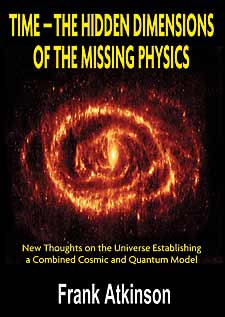Part VII
Time and Quantum Physics.
Perhaps one of the more obvious applications of the effects of time dilation lies in the increase of the force known as the Pauli exclusion force. That force relies on the quantum state of the electrons in an atom to hold the atom rigid and stop it from collapsing in on itself under gravity. No two electrons can occupy the same quantum state, so under great gravitational pressure the electrons would move apart at ever faster velocities.
Previously it was thought that as the speed of the electrons approach the speed of light on Earth they become relativistic and the increment in their force falls off. The electrons would eventually be able to be forced free of the nucleus and the matter becomes what is known as degenerate. It has been thought that in that form matter can be compressed into a much denser state. However, in the Tempo field theory, because the frequency or energy of a quantum wave such as an electron increases with time dilation then so also does its speed.
Under extreme gravitational pressure the electron's time is dilated without limit, so its speed will also increase and never become relativistic. It is thereby prevented from being forced from the atom to form degenerate matter. This brings into question black holes and neutron stars, which require matter to become degenerate to allow them to form.
Not only can black holes and singularities not be formed, they could not be black. They are meant to be black because it was thought that the gravitational pull is so great that the required escape velocity could not be achieved. However, as we have seen, the gravitational force equates to time dilation which means that the speed of light is increased. Hence, the speed of light is always increased to a speed faster than the escape velocity.
The atom produces the time that creates the gravitational effect. It is the atom also that increases the time dilation that in turn increases the velocity of the light. We therefore have a perfect symmetry, which it is impossible to break, precluding the formation of black holes and for any possibility of them being black.
The Wave/Particle Duality and The Uncertainty Principle.
If, as has already been conjectured, a quantum energy wave, such as light, propagates in its own time dimension, then the rate of such propagation will not be directly appreciable by us from our Tempo field dimension. It is impossible for the parameters pertaining to one time dimension to be applied to another. This means that an observer in Tempo field time, cannot perceive the function of a quantum wave. It is nonetheless, possible for us in Tempo field time, to capture the energy of a quantum wave in a detector. The detector will work in our macro time, that is to say, Tempo field time. Because the detector is operating in a different time dimension to that of the wave, the wave will appear in the detector 'time-frozen-out' as a point of energy, that is to say, as a particle, which we call a photon. So for example, the propagation of light will be in the light's own time dimension, whereas, the chemical reaction a photon makes on a photographic film will be in Tempo field time. This explains why it is said that light travels as a wave but arrives as a photon.
This model for the particle/wave duality of light gives an explanation for the two slit experiment. A photon of light will travel as a wave. If photons are propagated one at a time, each photon will, in its wave form be able to pass through both slits at the same time and then interfere with its own wave form on the other side. It will time-freeze-out as a spot on the photographic screen. The position of the spot on the screen will be determined by where the maximum energy is in the wave front when the wave is perceived in Tempo field time. This naturally will occur most where the wave is reinforced by constructive interference and least where it cancels itself out. The spots of light on the photographic film, simply by the law of averages, will gradually build up to form an interference pattern.
Time and Quantum Tunnelling.
Quantum tunnelling can take place when a particle can be described as having more potential energy than the rest of all its energy. While this cannot be the case in classical physics, it can in the world of quantum particle-wave duality. As mentioned above, as the potential energy of a particle goes down its frequency must go up, not only to maintain the balance of energy, but also to vary the speed of light and comply with the law of the conservation of energy. It will therefore be possible for a particle that has insufficient potential energy as a particle, to have sufficient energy in its quantum wave state, to be able to tunnel through barriers of matter or strong nuclear forces. This would explain how alpha particles can escape from nuclei during alpha decay, even though they are restrained by the strong nuclear interaction.
Click here to read Part 8 of this Digest, on 'Speeds Greater than c'.

